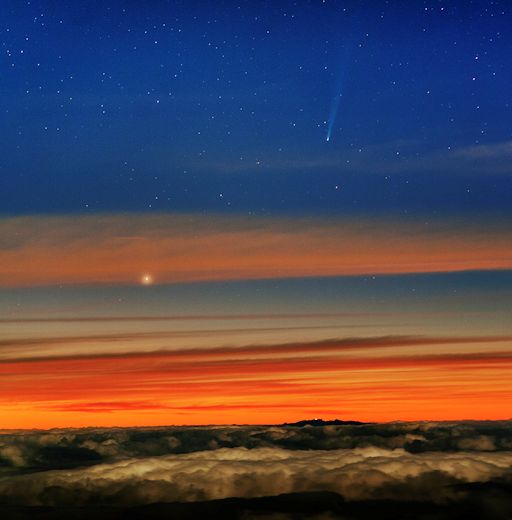ISON, THE DAWN COMET: Comet ISON is plunging toward the sun and brightening as it heads for a perilous close encounter on Nov. 28th. This morning, with the "final countdown" clock at T-7 days, Juan Carlos Casado photographed the sundiver over the Teide Observatory in the Canary Islands:
"The comet is over the distant island of Gran Canaria," he says, "while in the central cloud we can see the planet Mercury. ISON was at the limit of naked-eye visibility, but it was an easy target for my SLR camera with a small telephoto lens (85 mm focal length) on a static tripod and 6 seconds of exposure."
Because Comet ISON is moving into the rosy glow of dawn, it will soon be impossible for cameras on Earth to track it. NASA's fleet of solar spacecraft are about to take over. Later today, Comet ISON will enter the field of view of the STEREO-A spacecraft. The Heliospheric Imager on STEREO-A will pick up the comet just as Earth-bound telescopes begin to lose it. In the days that follow, STEREO-B, SOHO and the Solar Dynamics Observatory will join the hunt, providing continuous views of Comet ISON all the way to perihelion (closest approach to the sun) on Nov. 28th. Stay tuned!

Solar wind
speed: 333.5 km/sec
density: 1.0 protons/cm3
explanation | more data
Updated: Today at 1546 UT
X-ray Solar Flares
6-hr max: M1 1113 UT Nov21
24-hr: M1 1113 UT Nov21
explanation | more data
Updated: Today at: 1500 UT
![]()
Daily Sun: 21 Nov 13
Crowded near the sun's SW limb, sunspots AR1893 and AR1897 pose a threat for M-class solar flares. Credit: SDO/HMI
![]()
Sunspot number: 95
What is the sunspot number?
Updated 21 Nov 2013
Spotless Days
Current Stretch: 0 days
2013 total: 0 days (0%)
2012 total: 0 days (0%)
2011 total: 2 days (<1%)
2010 total: 51 days (14%)
2009 total: 260 days (71%)
Since 2004: 821 days
Typical Solar Min: 486 days
Update 21 Nov 2013
The Radio Sun
10.7 cm flux: 147 sfu
explanation | more data
Updated 21 Nov 2013
![]()
Current Auroral Oval:
Switch to: Europe, USA, New Zealand, Antarctica
Credit: NOAA/POES
![]()
Planetary K-index
Now: Kp= 0 quiet
24-hr max: Kp= 1 quiet
explanation | more data
Interplanetary Mag. Field
Btotal: 2.0 nT
Bz: 0.3 nT north
explanation | more data
Updated: Today at 1547 UT
![]()
Coronal Holes: 21 Nov 13
There are no large coronal holes on the Earthside of the sun. Credit: SDO/AIA.





